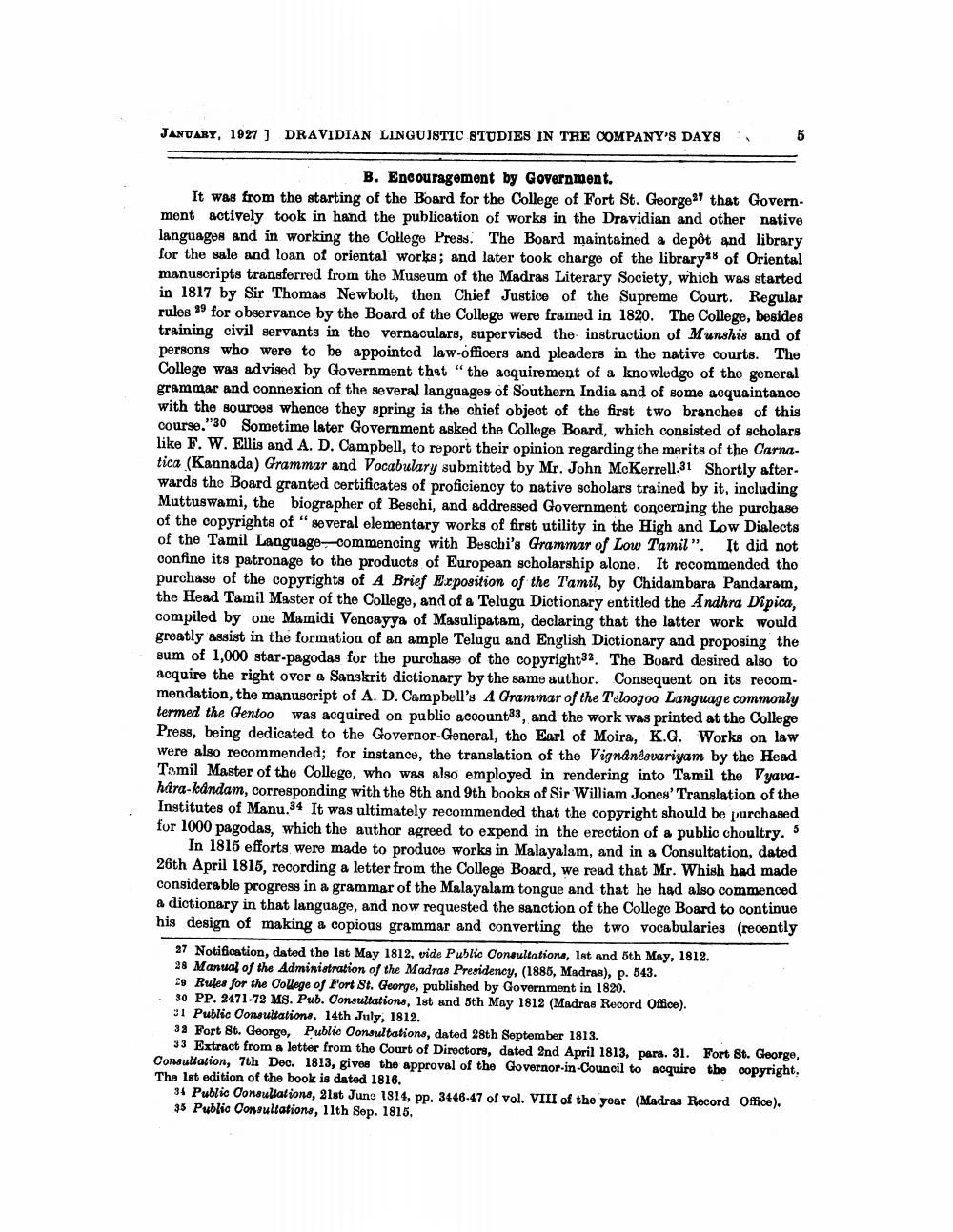________________
JANUARY, 1927] DRAVIDIAN LINGUISTIC STUDIES IN THE COMPANY'S DAYS
B. Encouragement by Government.
It was from the starting of the Board for the College of Fort St. George27 that Government actively took in hand the publication of works in the Dravidian and other native languages and in working the College Press. The Board maintained a depôt and library for the sale and loan of oriental works; and later took charge of the library18 of Oriental manuscripts transferred from the Museum of the Madras Literary Society, which was started in 1817 by Sir Thomas Newbolt, then Chief Justice of the Supreme Court. Regular rules 39 for observance by the Board of the College were framed in 1820. The College, besides training civil servants in the vernaculars, supervised the instruction of Munshis and of persons who were to be appointed law-officers and pleaders in the native courts. The College was advised by Government that "the acquirement of a knowledge of the general grammar and connexion of the several languages of Southern India and of some acquaintance with the sources whence they spring is the chief object of the first two branches of this course." ."30 Sometime later Government asked the College Board, which consisted of scholars like F. W. Ellis and A. D. Campbell, to report their opinion regarding the merits of the Carnatica (Kannada) Grammar and Vocabulary submitted by Mr. John McKerrell.31 Shortly afterwards the Board granted certificates of proficiency to native scholars trained by it, including Muttuswami, the biographer of Beschi, and addressed Government concerning the purchase of the copyrights of "several elementary works of first utility in the High and Low Dialects of the Tamil Language-commencing with Beschi's Grammar of Low Tamil". It did not confine its patronage to the products of European scholarship alone. It recommended the purchase of the copyrights of A Brief Exposition of the Tamil, by Chidambara Pandaram, the Head Tamil Master of the College, and of a Telugu Dictionary entitled the Andhra Dipica, compiled by one Mamidi Vencayya of Masulipatam, declaring that the latter work would greatly assist in the formation of an ample Telugu and English Dictionary and proposing the sum of 1,000 star-pagodas for the purchase of the copyright32. The Board desired also to acquire the right over a Sanskrit dictionary by the same author. Consequent on its recommendation, the manuscript of A. D. Campbell's A Grammar of the Teloogoo Language commonly termed the Gentoo was acquired on public account33, and the work was printed at the College Press, being dedicated to the Governor-General, the Earl of Moira, K.G. Works on law were also recommended; for instance, the translation of the Vignanêsvariyam by the Head Tamil Master of the College, who was also employed in rendering into Tamil the Vyava hara-kândam, corresponding with the 8th and 9th books of Sir William Jones' Translation of the Institutes of Manu.34 It was ultimately recommended that the copyright should be purchased for 1000 pagodas, which the author agreed to expend in the erection of a public choultry. 5
In 1815 efforts were made to produce works in Malayalam, and in a Consultation, dated 26th April 1815, recording a letter from the College Board, we read that Mr. Whish had made considerable progress in a grammar of the Malayalam tongue and that he had also commenced a dictionary in that language, and now requested the sanction of the College Board to continue his design of making a copious grammar and converting the two vocabularies (recently
27 Notification, dated the 1st May 1812, vide Public Consultations, 1st and 5th May, 1812.
28 Manual of the Administration of the Madras Presidency, (1885, Madras), p. 543.
5
29 Rules for the College of Fort St. George, published by Government in 1820.
30 PP. 2471-72 MS. Pub. Consultations, 1st and 5th May 1812 (Madras Record Office).
31 Public Consultations, 14th July, 1812.
32 Fort St. George, Public Consultations, dated 28th September 1813.
33 Extract from a letter from the Court of Directors, dated 2nd April 1813, para. 31. Fort St. George, Consultation, 7th Dec. 1813, gives the approval of the Governor-in-Council to acquire the copyright, The 1st edition of the book is dated 1816.
34 Public Consultations, 21st June 1814, pp. 3446-47 of vol. VIII of the year (Madras Record Office). 35 Public Consultations, 11th Sep. 1815.




